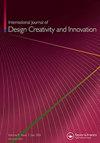考察情绪对设计结果质量和可行性的影响
IF 2.5
Q4 ENGINEERING, MANUFACTURING
International Journal of Design Creativity and Innovation
Pub Date : 2021-04-03
DOI:10.1080/21650349.2021.1890228
引用次数: 6
摘要
摘要本研究考察了生成的设计解决方案的质量和可行性与情绪、理性思维与直觉思维之间的相关性。有人假设,积极的情绪会带来更好的直觉思维,从而带来更高的设计质量和可行性。参与者是具有设计背景的大三和大四本科生,在以培养分析或直觉思维的方式解决9项7分钟的设计任务之前,他们被给予32分的布鲁内尔情绪量表(BRUMS)。Cronbachα被用来确认自我报告的情绪数据的可靠性和一致性。Spearman的相关性被用来说明情绪-绩效关系,表明在创造性直觉(CI)条件下,高设计解决方案质量与活力和精力充沛的情绪显著正相关,在问题解决直觉条件下与沮丧情绪显著负相关,而与抑郁显著负相关,CI条件下的疲惫和坏脾气。在理性思维条件下,高设计方案可行性与疲惫的情绪呈正相关,在CI条件下,与沉着和放松的情绪负相关。这些发现有助于进一步理解情绪如何影响直觉和分析问题解决中的设计结果,这可能对设计实践有启示。本文章由计算机程序翻译,如有差异,请以英文原文为准。
Examining the effects of mood on quality and feasibility of design outcomes
ABSTRACT This study examines the correlation between quality and feasibility of generated design solutions with mood and rational vs. intuitive thinking. It was hypothesized that positive moods lead to better intuitive thinking, which will result in higher design quality and feasibility. The participants, who were junior and senior level undergraduate students with a design background, were given the 32-point Brunel Mood Scale (BRUMS) before solving nine 7-min design tasks in a manner that cultivated either analytical or intuitive thinking. Cronbach’s alpha was used to confirm the reliability and consistency of the self-reported mood data. Spearman’s correlation was used to illustrate the mood–performance relationship, revealing that high design solution quality is significantly positively correlated with vigor and energetic mood in the Creative Intuition (CI) condition, and downhearted mood in the Problem Solving Intuition condition, while significantly negatively correlated with depression, worn-out and bad-tempered moods in the CI condition. High design solution feasibility was positively correlated with an exhausted mood in the Rational Thinking condition, and negatively correlated with composed and relaxed moods in the CI condition. These findings help further the understanding of how mood impacts design outcomes in intuitive and analytical problem solving, which may have implications design practice.
求助全文
通过发布文献求助,成功后即可免费获取论文全文。
去求助
来源期刊

International Journal of Design Creativity and Innovation
ENGINEERING, MANUFACTURING-
CiteScore
3.80
自引率
27.80%
发文量
15
期刊介绍:
The International Journal of Design Creativity and Innovation is an international publication that provides a forum for discussing the nature and potential of creativity and innovation in design from both theoretical and practical perspectives. Design creativity and innovation is truly an interdisciplinary academic research field that will interest and stimulate researchers of engineering design, industrial design, architecture, art, and similar areas. The journal aims to not only promote existing research disciplines but also pioneer a new one that lies in the intermediate area between the domains of systems engineering, information technology, computer science, social science, artificial intelligence, cognitive science, psychology, philosophy, linguistics, and related fields. The journal covers, but is not restricted to, the following topics: ·Theories on Design Creativity and Innovation ·Cognition of Design Creativity ·Innovative Process ·Inventive Process ·Analogical Reasoning for Design Creativity and Innovation ·Design Synthesis ·Method and Tools for Design Creativity and Innovation ·Representation of Design Creativity and Innovation ·Education for Design Creativity and Innovation ·Concept Generation and Inspiration.
 求助内容:
求助内容: 应助结果提醒方式:
应助结果提醒方式:


